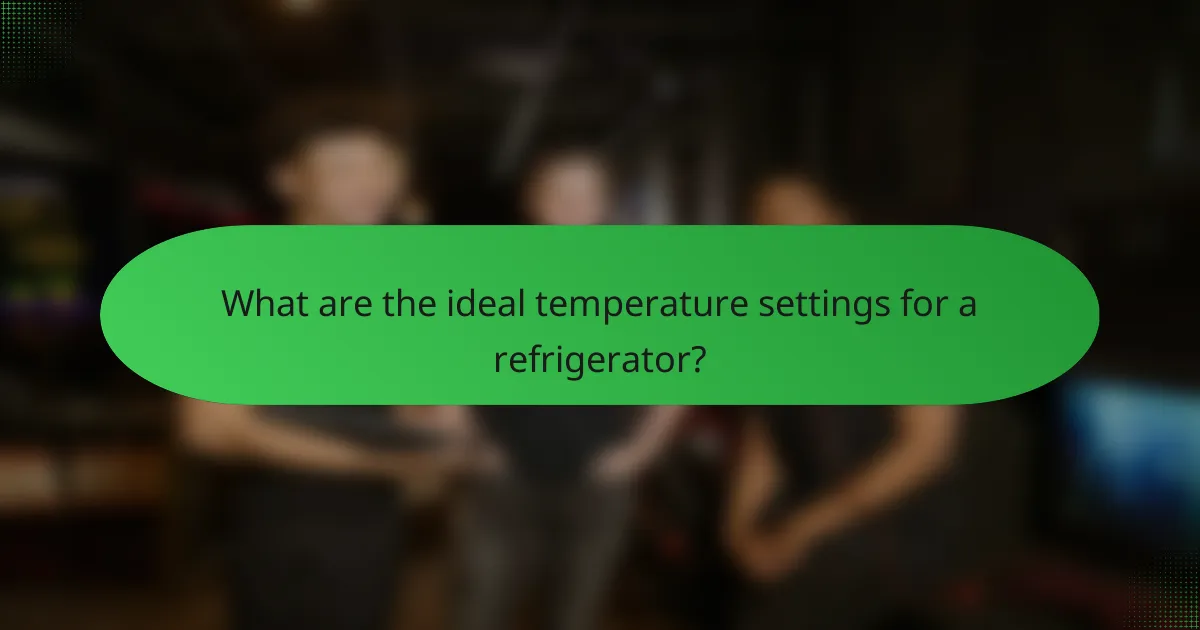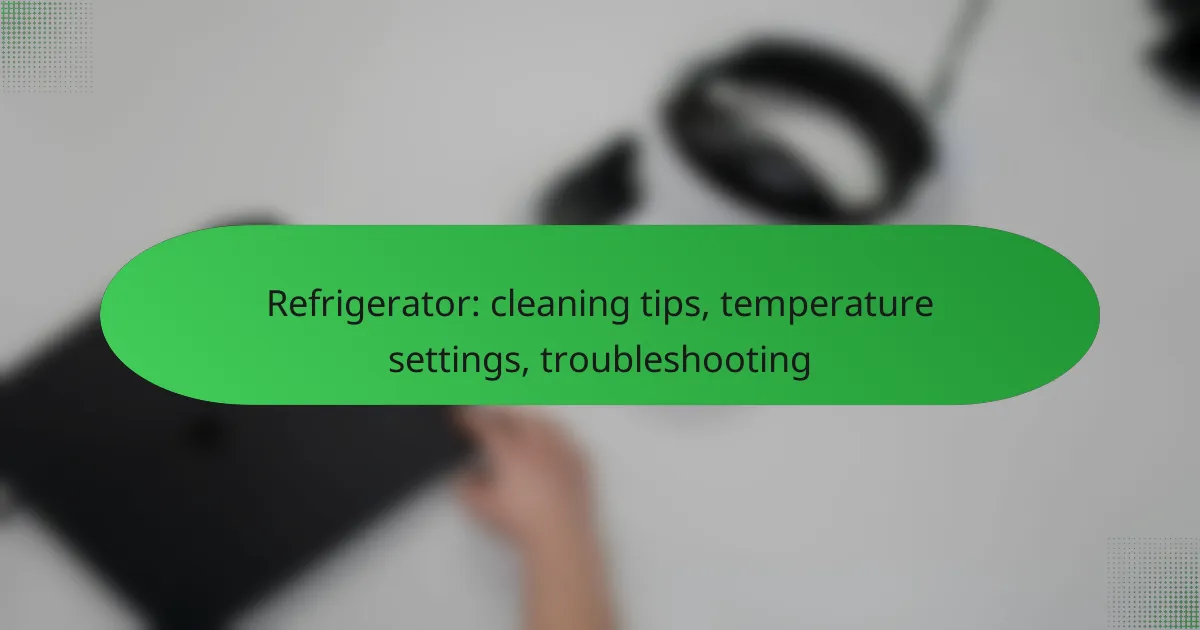Maintaining a clean and efficient refrigerator is essential for food safety and longevity. Regular cleaning helps eliminate odors and bacteria, while proper temperature settings—around 3°C (37°F) for the fridge and -18°C (0°F) for the freezer—ensure optimal food preservation. Additionally, knowing how to troubleshoot common issues can prevent costly repairs and keep your appliance running smoothly.

How to clean a refrigerator effectively?
Cleaning a refrigerator effectively involves a systematic approach to remove dirt, odors, and bacteria. Regular maintenance not only keeps your fridge hygienic but also ensures it operates efficiently.
Use a mixture of baking soda and water
A mixture of baking soda and water is an excellent cleaning solution for your refrigerator. Combine about four tablespoons of baking soda with a quart of warm water to create a gentle yet effective cleaner.
This solution helps neutralize odors and can be used on both interior surfaces and removable parts. Always rinse with clean water afterward to avoid any residue.
Remove and wash shelves and drawers
Take out all removable shelves and drawers for a thorough cleaning. Wash them with warm, soapy water, using a non-abrasive sponge to avoid scratches.
Ensure they are completely dry before placing them back into the refrigerator to prevent moisture buildup, which can lead to mold growth.
Wipe down interior surfaces
After cleaning the shelves and drawers, wipe down the interior surfaces of the refrigerator with your baking soda solution. Pay special attention to corners and crevices where spills may occur.
Using a microfiber cloth can help capture dust and debris effectively. Regularly wiping down surfaces can prevent the buildup of grime.
Clean the condenser coils
Cleaning the condenser coils is crucial for maintaining your refrigerator’s efficiency. Depending on your model, these coils are usually located at the back or underneath the appliance.
Use a vacuum cleaner or a coil brush to remove dust and debris from the coils at least once a year. This helps improve energy efficiency and prolongs the lifespan of your refrigerator.
Deodorize with activated charcoal
Activated charcoal is a natural deodorizer that can help eliminate odors in your refrigerator. Place a small bowl of activated charcoal in the fridge to absorb unwanted smells.
Replace the charcoal every few months for continued effectiveness. This method is chemical-free and safe for food storage areas, making it an ideal choice for maintaining freshness.

What are the ideal temperature settings for a refrigerator?
The ideal temperature settings for a refrigerator are crucial for food safety and preservation. Generally, the refrigerator should be set around 3°C (37°F) and the freezer at -18°C (0°F) to ensure optimal performance.
Set refrigerator temperature to 3°C (37°F)
Setting your refrigerator to 3°C (37°F) helps maintain food freshness and prevents bacterial growth. This temperature is cold enough to keep perishable items like dairy, meat, and vegetables safe without freezing them.
To achieve this, check the temperature settings on your refrigerator’s control panel. If your fridge has a temperature dial, a medium setting typically corresponds to this ideal range. Regularly monitor the temperature to ensure it remains consistent.
Set freezer temperature to -18°C (0°F)
The freezer should be set to -18°C (0°F) to effectively preserve food quality and prevent spoilage. At this temperature, food can be stored for extended periods without significant loss of flavor or texture.
Most modern freezers have a digital display or a dial that allows you to set this temperature easily. It’s advisable to check the temperature periodically, especially after a power outage, to ensure it returns to the proper setting.
Use a thermometer for accuracy
Using a thermometer is the best way to ensure your refrigerator and freezer are at the correct temperatures. A simple appliance thermometer can provide an accurate reading and help you avoid temperature fluctuations that could compromise food safety.
Place the thermometer in the center of the refrigerator and freezer for the most accurate readings. Check the temperatures regularly, especially after adjusting the settings, to confirm they stay within the recommended ranges.

How to troubleshoot common refrigerator issues?
Troubleshooting common refrigerator issues involves identifying problems such as power supply failures, door seal damage, incorrect temperature settings, and blocked vents. Addressing these issues can help ensure your refrigerator operates efficiently and prolong its lifespan.
Check for power supply issues
Start by confirming that your refrigerator is plugged in and that the outlet is functioning. You can test the outlet with another appliance to ensure it provides power. If the outlet is operational, check the refrigerator’s power cord for any visible damage.
If the refrigerator still does not turn on, inspect the circuit breaker or fuse box. A tripped breaker or blown fuse may need to be reset or replaced. If problems persist, consider consulting a professional electrician.
Inspect door seals for damage
Door seals are crucial for maintaining the internal temperature of your refrigerator. Check the rubber gaskets around the door for cracks, tears, or dirt buildup. A damaged seal can lead to cold air escaping, causing the appliance to work harder and consume more energy.
To test the seal, close the door on a piece of paper. If you can easily pull the paper out, the seal may need replacement. Regularly clean the seals with warm, soapy water to ensure they remain effective.
Examine the temperature settings
Incorrect temperature settings can lead to food spoilage or freezing. The ideal refrigerator temperature is typically between 1°C and 4°C (34°F to 40°F). Check the thermostat to ensure it is set within this range.
If the temperature is too high or too low, adjust the settings accordingly and allow 24 hours for the temperature to stabilize. If issues persist, consider checking the thermostat for malfunction or consulting the user manual for specific troubleshooting steps.
Clear blocked vents
Blocked vents can restrict airflow, leading to uneven cooling and potential food spoilage. Inspect the vents inside the refrigerator and freezer compartments for any obstructions, such as food items or ice buildup.
Ensure that air can circulate freely around the vents by rearranging items in the refrigerator. If ice is blocking the vents, defrost the appliance according to the manufacturer’s instructions. Regularly check and clean the vents to maintain optimal airflow.

What are the signs of a failing refrigerator?
Signs of a failing refrigerator include unusual noises, inconsistent cooling temperatures, and water pooling inside or underneath the appliance. Recognizing these indicators early can help prevent food spoilage and costly repairs.
Unusual noises coming from the appliance
If your refrigerator is making strange sounds like buzzing, clicking, or grinding, it may indicate a problem. These noises can stem from a malfunctioning compressor, a failing fan, or even loose components. Pay attention to the type and frequency of the sounds to determine if immediate action is needed.
To troubleshoot, check if the appliance is level and ensure that items inside are not obstructing the fan. If the noises persist, consider consulting a technician for further inspection.
Inconsistent cooling temperatures
Inconsistent cooling temperatures can manifest as food spoiling more quickly or ice forming in unexpected places. This issue may arise from a faulty thermostat, blocked vents, or a malfunctioning compressor. Regularly monitoring the internal temperature can help you catch these problems early.
For optimal performance, the refrigerator should maintain a temperature between 1-4°C (34-40°F). If you notice significant fluctuations, it may be time to check the appliance’s settings or seek professional help.
Water pooling inside or underneath
Water pooling inside or underneath your refrigerator is a clear sign of a potential issue. This can be caused by clogged defrost drains, damaged door seals, or a malfunctioning water supply line. Addressing these problems quickly can prevent water damage and mold growth.
To resolve pooling, start by inspecting the drain for blockages and cleaning it if necessary. Check the door seals for any cracks or gaps, and ensure that the water supply line is functioning correctly. If problems persist, contacting a professional may be necessary.

How to maintain a refrigerator for longevity?
To maintain a refrigerator for longevity, regular cleaning and proper temperature settings are essential. Ensuring that the appliance operates efficiently can prevent breakdowns and extend its lifespan.
Cleaning tips for your refrigerator
Regular cleaning is crucial for maintaining a refrigerator. Aim to clean the interior at least once a month, removing expired food and spills. Use a mixture of warm water and mild detergent to wipe down shelves and drawers.
Don’t forget to clean the condenser coils located at the back or beneath the refrigerator. Dust and debris can accumulate, causing the appliance to work harder, which may lead to increased energy consumption and potential breakdowns. A thorough cleaning every six months is advisable.
Optimal temperature settings
The optimal temperature for a refrigerator is typically between 1°C and 4°C (34°F to 39°F). Keeping the temperature within this range helps preserve food freshness and prevent bacterial growth.
For the freezer, aim for a temperature of around -18°C (0°F). Regularly check the settings and use a thermometer to ensure accuracy, as fluctuating temperatures can compromise food safety.
Troubleshooting common issues
If your refrigerator is not cooling properly, first check the temperature settings and ensure the door seals are intact. A faulty seal can allow warm air to enter, reducing efficiency.
Listen for unusual noises, which may indicate issues with the compressor or fan. If the appliance is leaking water, inspect the drain pan and ensure it is properly positioned. For persistent problems, consulting a professional may be necessary to avoid further damage.
